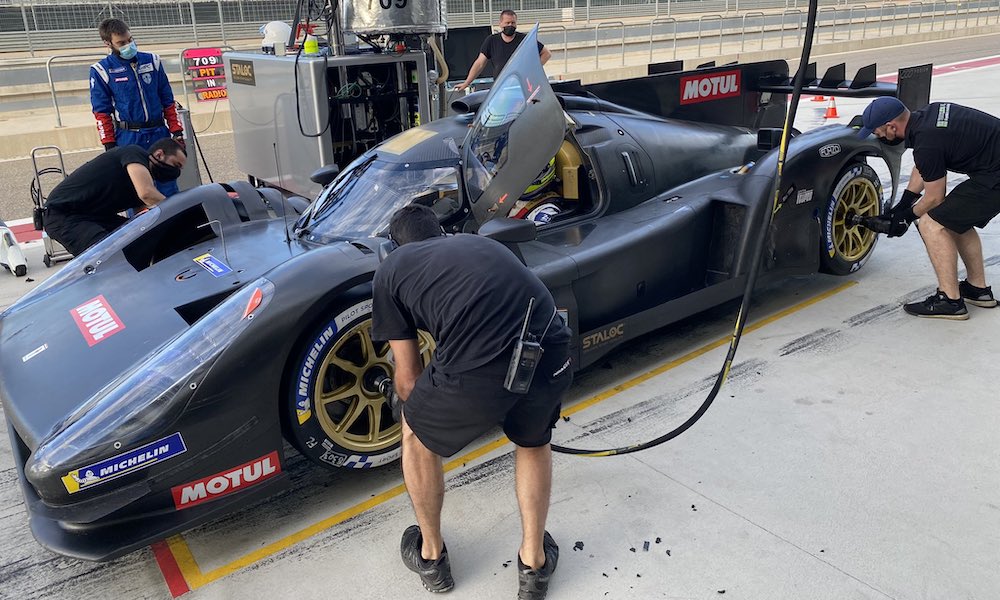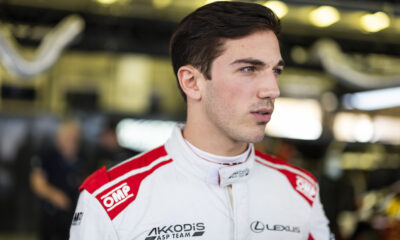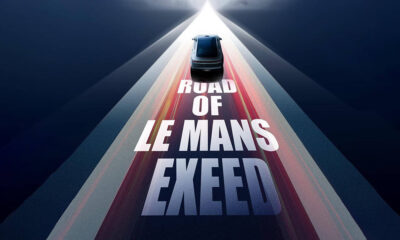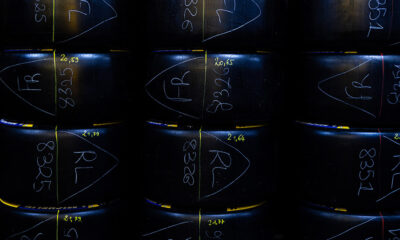A recent 30-hour test of the new Scuderia Cameron Glickenhaus 007 Le Mans Hypercar at Aragon gave “very encouraging” signs about the car’s reliability ahead of its FIA World Endurance Championship debut, according to Pipo Derani.
Derani was one of six drivers to turn laps aboard the Pipo Moteurs-powered V8 non-hybrid prototype during its two-day session at Aragon last Friday and Saturday.
The triple Mobil 1 Twelve Hours of Sebring winner told Sportscar365 that despite some minor issues, the car was able to run consistently and achieved its objectives.
The SCG 007 LMH will make its first race appearance next weekend at the 8 Hours of Portimao with Ryan Briscoe, Richard Westbrook and Romain Dumas sharing the wheel.
“As a driver, in terms of performance, you’re always looking at details on where you can improve and so on,” explained Derani. “That wasn’t really the point of the test.
“It was more about just being able to run, run, run. And we were able to do that. That’s very positive and encouraging.
“It gives us good hope that there is a chance that this year’s Le Mans will be won on reliability and not on pure speed.
“Of course, there are still things to be done. But it’s very encouraging that the car has run as it has, and the things that broke are things that we can easily fix. So it’s quite positive in that area.”
Derani, whose other time behind the wheel came during the 007’s second test at Monza in March, indicated the car has progressed significantly since then.
“At Monza some of the things weren’t working, like traction control,” said the Brazilian. “Now the step forward was good, in terms of getting some of the systems working.
“There are still a lot of refinements we’ve got to do, for TC to be smoother and things like that. But it’s encouraging how quickly they developed from Monza to now in terms of all the electronics and systems in the car.”
SCG owner Jim Glickenhaus said that “no real issues” were encountered during the test, with the main hitch being a broken cable that gave way after 8,000 km of total use between the car’s previous tests at Vallelunga and Monza and the latest outing in Spain.
“We’re just making a better cable and we’ll secure it better,” Glickenhaus told Sportscar365.
“We did a lot of in and out at the end, just testing should we have a problem, bringing it into the garage quickly.
“We did refueling, tire changes and we got a lot of testing on the crew. The car is very strong. It runs and runs. It’s done 10,000 km [overall], chassis No. 708.
“That car is going to be completely rebuilt and the chassis will be replaced.
“We ran 24 hours as it was a race, and the last four hours we changed it. We took the nose off, simulated that we had an issue with a spring…”
The new No. 709 chassis was also at Aragon and shook down ahead of its transportation to Portimao where Briscoe, Westbrook and Dumas – who was the only absentee from testing due to his GT3 racing commitments – will give Glickenhaus its WEC debut.
Franck Mailleux, Olivier Pla and Gustavo Menezes also drove at Aragon.
The replacement No. 708 chassis will be entered into the 6 Hours of Monza, running alongside its sister car as what Glickenhaus described as a “gen two” homologated chassis that is 20 kg lighter than the original which did the lion’s share of track testing.
“We were able, after the crash test, to take 20 kg out of the chassis,” he explained.
“There’s no problem with the chassis. It’s just that now we have one that weighs 20 kilos less, it enables us to balance the car a little better. The No. 709 has the new chassis.”
Aragon marked SCG’s most extensive running on Michelin’s rear-wheel-drive family of new LMH tires. These are different from the four-wheel-drive tire family used by the Toyota GR010 Hybrids and the grandfathered LMP1 tires of Alpine Endurance Team.
“I did [race stints] myself and together with other drivers,” explained Derani. “We were able to combine some work on tires, with one using the tires from the other.
“In that sense, at some points we had very encouraging and positive signs of real performance. And at other points we had some doubts.
“It’s a track that is very difficult in that area, because track conditions change so much.
“And the heat changes the feeling of the car. But in general, it was really positive, because it’s an extremely demanding track on tires.”
According to Glickenhaus, the Michelin tires generally ran well during the first half of a double stint but were found to fade quicker than expected through the second stanza.
He also said that Michelin brought some “next generation” tires that could potentially be used by rear-wheel-drive LMH cars after the 2021 WEC season, and that these offered less degradation over a race simulation run.
A pair of Oreca 07 Gibson LMP2s from Risi Competizione and DragonSpeed also tested, enabling Glickenhaus to observe his car directly against the second-tier prototypes.
Glickenhaus said the 007 LMH was around “1.2 to 1.5 seconds” quicker than the LMP2s during the first half of a double, but the gap came down dramatically during part two.
However, he expressed concern that the margin in the first stint needs to be larger still, in order to create adequate stratification between the two prototype classes in races.
“At Aragon we were a clear 1.5 seconds faster than the fastest LMP2 laps during a stint,” said Glickenhaus. “But, in the second [stint] of tires, we weren’t. That’s just physics.
“The tires went away, and no one can win back a second and a half. The ACO know about it. I don’t think anybody should be shocked. If you listen to Toyota’s comments when they say they have to be in a different ballpark to the LMP2s: that’s the answer.”
“Good Energy” Within Experienced Driving Squad
Derani described the SCG crew as having a “good energy” and that the experienced drivers on the roster are collectively helping to push the car’s development, alongside technical partner Podium Advanced Technologies and operational partner Joest Racing.
The Glickenhaus lineup combines drivers who between them hold outright victories at the 24 Hours of Le Mans, Rolex 24 at Daytona and 12 Hours of Sebring.
“There is a lot of camaraderie, in terms of that we speak between ourselves in meetings after the tests,” said Derani.
“There seems to be a very straightforward direction in terms of all the new things that need to be done and fixed, so that it’s a much easier car to manipulate during a race.
“That’s been very good, because it drives the team to know exactly where they need to work.
“Once you give them this direction, and you see that they have been able to accomplish everything you request in such a short period of time, it’s very rewarding and it gives you a good energy.
“You feel that you are a part of something that can be good, and that energy pushes everyone forward.”

























